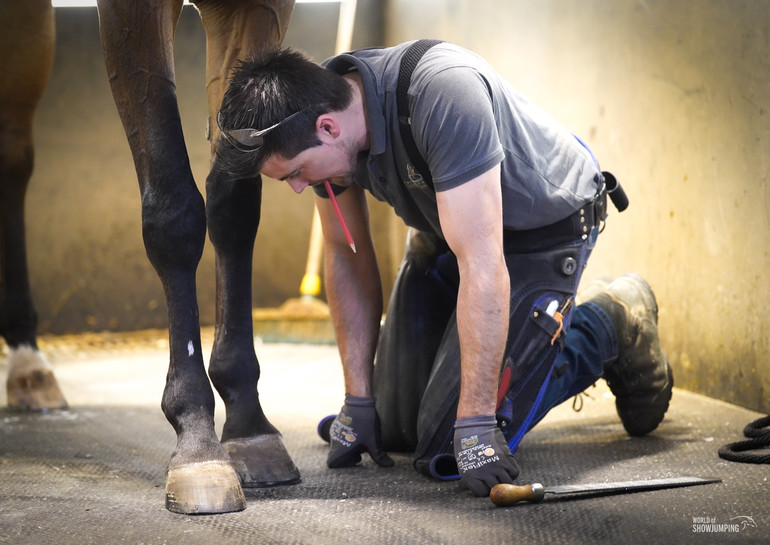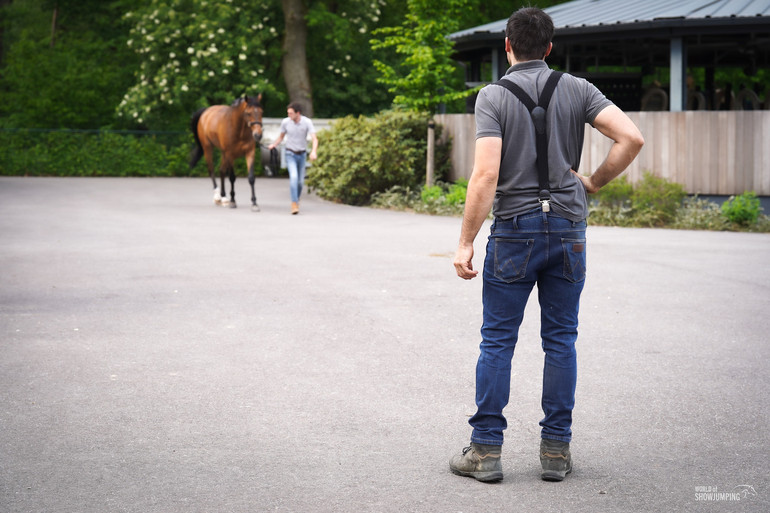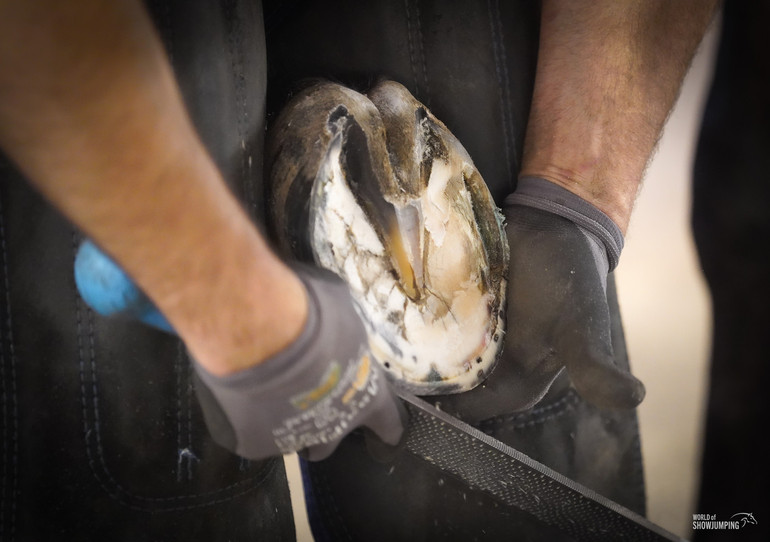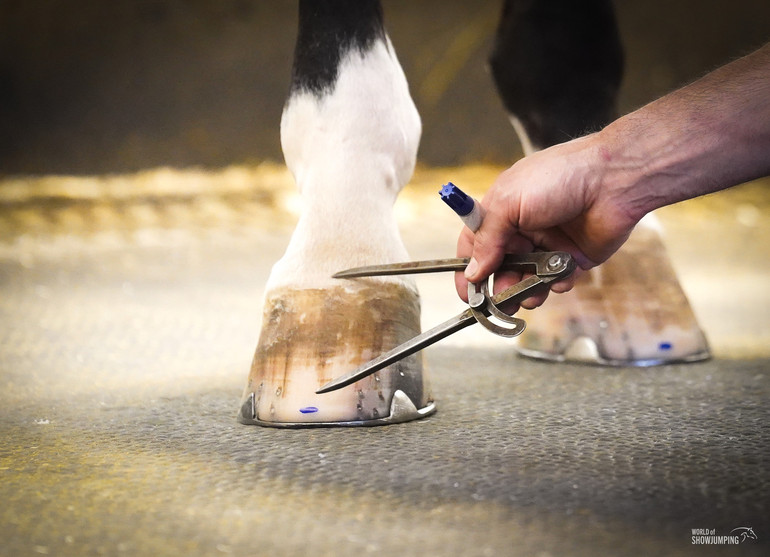Text © World of Showjumping
“There have been different hypes along the years: It used to be aluminium, now it is the barefoot trend, and it will be interesting to see what comes next,” Christian Hagl tells World of Showjumping.
The 33-year-old farrier, who is based in Munich, Germany – but who has clients all over the world – believes in simplicity. “Keeping things simple is so easy, but everyone seems to want to be a specialist and forget about the basics and how nature actually works. In my job, helping the horses feel comfortable is one of the best parts of what I do: If I start on a sore horse with problematic feet and end up with healthy, sound and strong hooves, that is just incredible.”
As natural as possible
 "Some horses wear off their feet unevenly, and this creates uneven joint spaces, which brings trouble sooner or later; having too much pressure on one part of the joint is not comfortable," Hagl explains. "I measure the angles, the length of the feet and the distance from the coronary band down. I mark my trim line, and measure the fetlock before so that I know the length of it."
"Some horses wear off their feet unevenly, and this creates uneven joint spaces, which brings trouble sooner or later; having too much pressure on one part of the joint is not comfortable," Hagl explains. "I measure the angles, the length of the feet and the distance from the coronary band down. I mark my trim line, and measure the fetlock before so that I know the length of it."
Hagl believes that the basic principle when shoeing horses is to try to stay as natural and simple as possible. “Keeping the horses comfortable is my number one goal. However, with some horses you need more complicated solutions due to their individual issues like hoof cracks or underran heels. If you have hoof cracks, one good solution can be to let the horses be barefoot until the cracks heal. The biggest problem with horses that have hoof cracks is that to heal hooves need time and those horses would normally need a break – which is something riders don’t want to do. Instead, they are willing to do pretty much anything as long as they don’t have to take a break – and time plays an essential role when it comes to hooves.”
Time plays an essential role when it comes to hooves
“For me, shoeing is about finding the perfect schedule of keeping the horses in the same position throughout the shoeing cycle and keeping them comfortable,” Hagl continues. “I try to see all my clients in a cycle of five to six weeks, most of the time six weeks in winter and every five weeks in the summer. I have to find the perfect angle for each horse and for every foot, and keep them on this angle. Mainly, if a horse comes back with the same angles five weeks later, it tells me that all the structures are in balance and that the horse does not feel too much pressure or discomfort. Having enough substance – foot – and keeping all the structures in balance are key in ensuring that the horses are sound and comfortable.”
“When I get a new horse to shoe, an ideal situation for me as a farrier is to have an x-ray done of the feet, so that I can see what is really going on,” Hagl continues. “And from there on, you need to work as a team – with the groom, the rider and the vet. Perfect shoeing can only be done by working together, and one type of shoeing never fits all year long. You need to adjust continuously, read the feet and the horses, and make the best possible plan accordingly. It is all about having a plan and having enough foot under the hoof bone, because this is what protects the horse. Sometimes you need to change the hoof angles for certain periods of time if you for example have issues with the tendons, but it is all about having a plan and involving everyone.”
It is all about having a plan and having enough foot under the hoof bone, because this is what protects the horse
Hagl watches the horses walk and trot on a straight line and on a circle before and after he shoes them. “If I don’t watch them before, I cannot know what issues they have, or how they like to move,” he explains. “I prefer to see them on both soft and hard ground. It is also about double checking if the horses are sound. To stay sound, horses need to have parallel joint spaces and you can help a horse with shoeing. Some horses wear off their feet unevenly, and this creates uneven joint spaces, which brings trouble sooner or later; having too much pressure on one part of the joint is not comfortable. I measure the angles, the length of the feet and the distance from the coronary band down. I mark my trim line, and measure the fetlock before so that I know the length of it. I want to have a foot length as long as the fetlock length, so that biomechanically the horse is in balance. Most barefoot horses actually don’t have enough toe-length, meaning that they are not ideally balanced biomechanically, and that is one of the reasons why I am so impressed with how well they are doing regardless.”
The pros and cons of going barefoot
“In the end, with any hype we have had, we usually seem to return to the normal shoeing,” Hagl explains about trends – currently, the most dominant being the barefoot one. “The barefoot system should be thought of as another tool, which we did not use enough in the past. One of the biggest positive results from the barefoot hype is that it kind of reveals the bigger issue in the farrier world: We don’t have enough professionals. Good farriers, if they don’t look after themselves, easily take on too much work. When you have too much work, you do compromise somewhere – and you get faster. As a result, the quality of your work suffers. It is easy to get too pulled into the job, and forget the importance of seeing how others work, keeping your mind open and staying educated. This is a huge problem.
The main thing that horses really seem to love about being barefoot is losing the weight of the shoes
"When you have farriers without good eye and good skills, taking the shoes off is of course going to be a relief for the horse. It does not take much; a wrong angle, bad conformation, too much pressure, wrong heels, soreness… If your starting point is bad shoeing, your horse is always going to improve by taking the shoes off. However, it should not be forgotten that changing to barefoot alters the way a horse moves and their rhythm.”
“The main thing that horses really seem to love about being barefoot is losing the weight of the shoes. Also, if we ourselves take our shoes off and walk on nice, soft sand, it is an amazing sensation. For barefoot horses, the hoof mechanism is more flexible. Those are the main points that make some horses feel so comfortable barefoot; there is no weight, no pressure, the hoof mechanism can move freely. If you watch barefoot horses on a highspeed camera, they become faster when compared to horses with shoes."
For barefoot horses, the hoof mechanism is more flexible
"Plastic shoes are probably the next thing, but they wear off even faster than aluminium, which was popular because the shoes were lighter, but still protected the feet. Going lighter than aluminium or plastic means going barefoot, but then we can only protect the feet by putting on boots and controlling the surfaces. Hence, a stable with barefoot horses has to be managed totally differently, starting from the surfaces, like the ground in the walker and in the paddocks. If the soft tissue gets a lot of pressure from bad surfaces, you can get in trouble, with abscesses and lameness.”
“I don’t know where this hype will lead,” Hagl says. “Almost all barefoot horses that I have seen are getting too short and become sensitive on the sole pressure if they are not properly managed. Sooner or later, the hooves start to break and horses get sensitive and then it can be too late; if you are in the middle of a competition season, getting into a situation like this will be a huge issue."
Horses that can keep going barefoot for long periods of time are simply really well managed
"Horses that can keep going barefoot for long periods of time are simply really well managed. I am actually impressed about the barefoot system and how the horses are reacting and moving. It is incredible that it took so long for the community to return to this system. However, it only seems to work for the jumping horses; dressage horses are not as comfortable barefoot, and seem to lose a part of their movement without the weight of the shoes, whereas jumping horses get faster.”
All about the management
It is really important to remember that going barefoot simply does not fit every individual horse, Hagl highlights. “Everyone has to do what is best for their horse,” he says. “In the end, when it comes to having horses barefoot, it is all about the management. Having horses without shoes is so much more work, and this is something people seem to forget. It is really not only about pulling the shoes off and then leaving the hooves alone – on the contrary. Also, many argue that it is cheaper to have horses barefoot, but I find it hard to agree with that. It probably seems cheaper if you only look at the invoice from the farrier, but in my opinion, the more horses you have barefoot, the more staff you need – because it is all about the management when you have your horses barefoot.”
Having horses without shoes is so much more work, and this is something people seem to forget
“To begin with a barefoot system, you need to start on good, healthy feet that have solid walls,” he continues. “If the feet are too flat and thin to start with, it is not going to be a great success or at least it will take longer to make it work. Also, you need to have enough staff, and good staff: It is the grooms that do the most work when horses are barefoot.”
“The management of barefoot horses begins with avoiding water: Water makes the feet soft, and brings the bacteria into the hooves. If you have a weak hoof, and the horses get washed daily, the sole gets thin, the hooves get soft and your horse loses their comfort zone,” Hagl points out. “To keep your horse comfortable, you need enough space under the coffin bone. However, if you take x-rays of barefoot horses, they are usually too short in their feet if you think about comfort zone – which is amazing, as some horses still feel ok with this. However, with time, barefoot horses do grow stronger hooves. I think it is mother nature telling them that they need to be stronger.”
Everyday care
When it comes to everyday care of the hooves – barefoot or not – Hagl prefers as little water as possible and normally does not promote use of hoof grease. “In most cases, grease is expensive and only makes the hoofs look shiny,” he says. “However, hoof grease can support the feet from getting too wet since grease is water repellent. Therefore, if my clients tend to wash their horses a lot, I tell them to use hoof grease to protect the hooves – but this also depends on the individual, because sometimes, the hooves do need a bit of water if they are too dry. You really cannot make a general rule, but basically what you want is a dry hoof, but not a dry coronary band – that is the secret. Usually, the advice I give to my clients is to brush the feet, then put hoof hardener on and a hoof grease on top to close the hoof hardener in. This way, the hooves get stronger. However, at the same time you should keep the coronary band as smooth and soft as possible; this can be done with just a basic body lotion.”
The frog is a part of the hoof that loves to work, and most farriers don’t respect it and its function enough
“The frog is the heart of the foot; this is where the engine really starts, because it pumps the blood – it is all about the frog actually, as the frog starts the blood supply,” Hagl continues. “The frog is a part of the hoof that loves to work, and most farriers don’t respect it and its function enough. The frog is our most important partner, and I often see frogs being cut too much. If you watch the frog in a simple shoe, the frog should always have contact to the floor – because it is a pump. If you watch barefoot horses, the biggest part of the hoof that is touching the floor is the frog.”
“When it comes to keeping the frog healthy, it all starts with cleaning the boxes,” Hagl points out. “Usually, the main reason behind horses having bad feet and rotten frogs is the boxes not being taken care of properly – leaving the horses standing in dirt. When you clean the box, you should make sure to clean the feet at the same time, to make sure the hooves are on a really clean surface – otherwise the dirt will stay in the hooves even if the box might look clean. The dirt from the box brings in bacteria to the feet, and makes the feet wet and soft. Taking good care of the boxes is essential; it is the starting point of healthy hooves. We could manage more horses on barefoot or with more simple shoeing if we had cleaner, better managed boxes. The best thing to do for the frog is to clean, clean, and clean. It is all about keeping the frog clean, but not cleaning with water. It is water that brings in the bacteria. I think it is one of the biggest misconceptions; everyone seems to think that cleaning the feet has to be done with water.”
Taking good care of the boxes is essential; it is the starting point of healthy hooves
“There are a few things I wish everyone would do better when it comes to hooves,” Hagl concludes. “Clean the boxes better, open your eyes and react to what you see. Sometimes people notice a minor issue, but only keep watching it without doing anything. If you react early, you don’t get into such big trouble – sometimes it simply is too late, and an issue that would have been super simple to solve in the very beginning turns into a massive problem.”
14.5.2024 No reproduction of any of the content in this article will be accepted without a written permission, all rights reserved © World of Showjumping.com. If copyright violations occur, a penalty fee will apply.
















